 |  |
| | |
| | VROOM
Vehicles of Registration and Omniscient Observational Mechanics, 2005 ‘You can’t find a new land with an old map’
English proverb 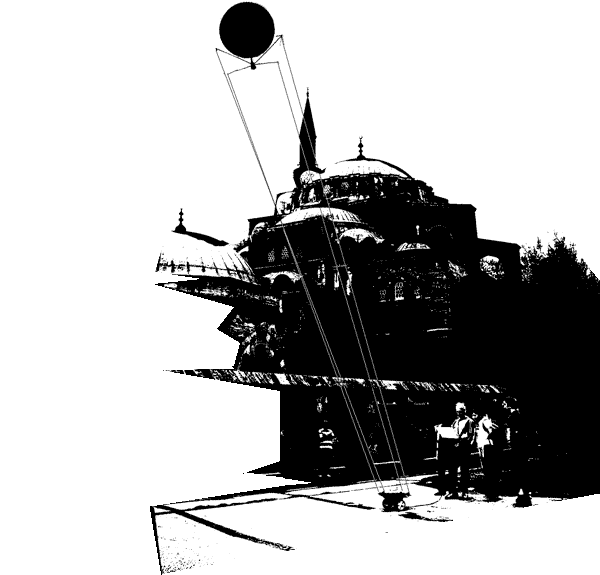
A collaborative project, seminar and exhibition of vehicles for re-reading the urban situation for Istanbul Fragmented event during the 9th Istanbul Biennale in September 2005. Background
VROOM workshop has been initiated by Otto von Busch, Evren Uzer and Klas Ruin, as a medium to produce ‘vehicles’ to register, to document and/or replace/intervene the fragments of a city using alternative methods and tools. Main aim is to shift our everyday look to the city and shake our grounds that we usually take for granted. Vehicles within VROOM deliberately never provide complete answers to ‘general city-planning questions’. Instead they record or produce specific information on life in action. Being peripheral and specific, these surveys tend to reveal valuable information on levels of everyday life that otherwise is neglected in reading the city as a whole. The goal is the extracted fragment, the beginning of telling a story…
Vehicles of registration have many names and a long history. Machines, robots, instruments etc have been widely used as tools for mapping actions. Surrealists and situationists have worked with it as well as a number of contemporary architects and artists in order to research the ongoing changes that take place in the city.
The ambition with the VROOM workshop is partly to invite people already involved in work with ´vehicles of registration´ where the vehicle exists but also make new production possible for this specific occasion. Structure
The aim for VROOM is to gather, test, exhibit and discuss different vehicles produced locally and brought to Istanbul Fragmented. Different groups have designed and produced a vehicle for their city that gathers and records information and data of different forms. This vehicle is locally produced and specified for the city of origin and observing a specific urban question on that city.
We invited groups with different backgrounds mostly concerned with urban conditions – architects, urban planners, artists and interventionists – with the following main conditions: the vehicles that are produced for registering the city shouldn’t be exceeding cabin luggage size and they should be operated by one driver.
Every invited group produced their own vehicle according to the specifications of the workshop and looking at their own urban situation with the senses of their own prosthesis. The documentation of their observations are collected and brought together with the vehicle to Istanbul for comparisons and discussions.
Method
The project has been open for participation from different groups and collectives trying to span as wide field of practices as possible – but all focusing on the urban situation as the field of interest. Universities as well as independent practitioners were contacted for the “call for vehicles”. The first focus was to gather already interested and known groups to set a high standard of works.
Project groups developed their vehicles with the facilitation of VROOM group where needed.
In city of origin;
The design and production of the vehicles and the collection of data is the backbone of the workshop. Producing a specific mechanical prosthesis vehicle for observation of a limited field of interest based on a situation in the city of origin. The process of gathering information and/or living traces during this process was documented as well. In Istanbul;
The vehicle asks a question and gave a new/different answer in Istanbul acting as a mirror for the connections between the involved groups and their hometowns. Vehicles are operated by the “drivers” with the assistance of students from ITU, METU and Mimar Sinan Uni. Outcomes for both processes (hometown and Istanbul) are discussed and exhibited during Istanbul Fragmented and is documented in a publication (A book and a DVD). |
| | |
| | 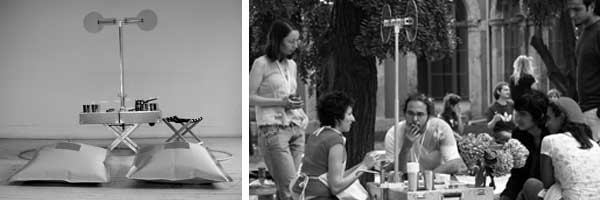 |
| |
DISARM
ATOPIA, Jane Harrison, David Turnbull & Alan Smart and Lize Mogel (host for Istanbul phase)
new york/usa
DISARM comprises an ensemble of devices that engage the public by offering a cup of coffee and monitor interactions with people and the urban milieu by recording, transcribing and relaying ’chatter’. A ‘host’ carrying the suitcase about public spaces in New York (Ground Zero; August 2005) and Istanbul (Taksim Square, September 2005), ‘sets up’ by opening the suitcase, unfolding the collapsible parts, taking out the coffee apparatus stored in the suitcase’s protective red foam interior, deploying the cushions (filling them with water), and setting up the wireless ‘hotspot’. While the suitcase, a prospective bomb-carrying armature, has become an icon that arouses suspicions in both cultures, DISARM has the potential to dismantle the suspicions of people in both cities whose sense of mistrust has been heightened by recent acts of political violence. Passersby are invited to have a coffee - the guest must sit down while the boils the water, brews the coffee, etc. DISARM, then, spontaneously defines a social nexus or site within larger public space through offering coffee, a traditional ritual familiar to both residents of New York and Istanbul.
(Excerpted from the VROOM booklet text of ATOPIA, Jane Harrison, David Turnbull & Alan Smart)
|
| | |
| | 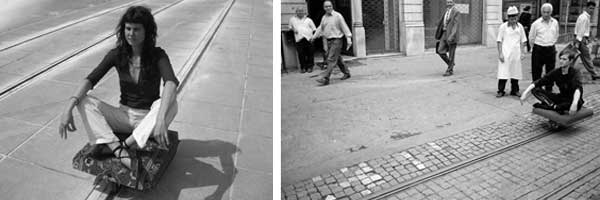 |
| |
TRAIN
HEHE - HEIKO HANSEN, HELEN EVANS PARIS/FRANCE
Between urbanism, vehicle design and automation, this project is a research into the aesthetics of movement and travel. The experience of driving Tapis Volant is semi-automated: The vehicle glides along the tracks, accelerated by the act of tilting forward and comes to a standstill when leaning back. This method of operation shifts the ratio between automation and control: allowing for an unconscious modus operandi. The experience is unlike driving a car, where the driver is exposed to a constant flow of complex control mechanism.
The TRAIN project uses a method of reverse cultural engineering: by navigating freely through time, space and culture, it is possible reinvent an older technology without accepting long established conventions. Technological processes develop like a fractal image: In the center of this image is the original invention and towards its edges are the smaller, more and more marginal sub-innovations, which can never be bigger than their creator. (Excerpted from the VROOM booklet text of HEHE/ Heiko Hansen and Helen Evans’)
|
| | |
| | 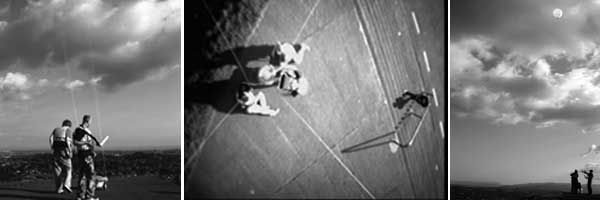 |
| |
Constructing Purgatory.
James Charlton. Sam Morrison Auckland/New Zealand
‘Constructing Purgatory’ explores the interpretative nature of visual representation in relation to the graphic visualisation of quantative data. The project seeks to extend our understanding of representation as a vehicle of association through which a dialogue with that being represented is established. Composed of three parts; A helium filled meteorological balloon, carries a wireless video camera aloft; A mobile ground unit formed by a plastic welded inflatable life-ring accommodates interlocking plastic housing; and lifejackets fitted with harnesses to house recording and processing equipment. Recordings were taken at seven different locations (one for each level of Purgatory). Four recordings were made in Auckland, New Zealand while the remaining three recordings were made in Istanbul. (Excerpted from the VROOM booklet text of James Charlton & Sam Morrison)
|
| | |
| | 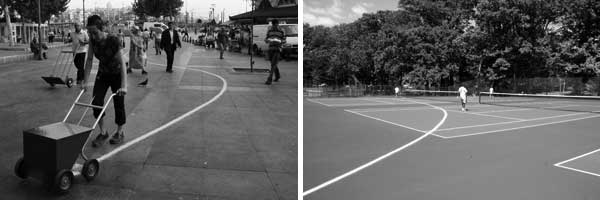 |
| |
CRUMB MERIDIAN
MARISA JAHN, STEVE SHADA Hartford, Connecticut/ USA
Crumb Meridian 2 is a public performative installation that literalizes invisible geopolitical boundaries by presenting them in human scale. With the aid of a buggy traditionally used to leave lines of chalk on soccer fields, the vehicle leaves a line of bread crumbs through various sites in two cities located along the same degree of latitude (41 degrees North). Erased by hungry pigeons, passersby, cars, ants, wind, and other unknown elements in each respective site, the project draws comparison between Hartford and Istanbul and within the cities themselves, invoking a conversation about difference and sameness, particular vs. universal, individual vs. collective. (Excerpted from the VROOM booklet text of Marisa Jahn & Steve Shada)
|
| | |
| | 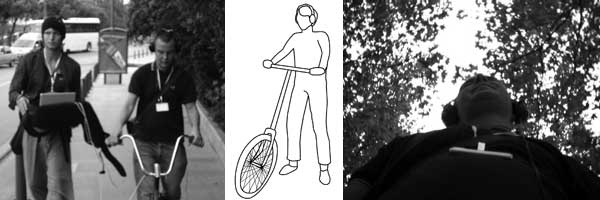 |
| |
SMEE/SEMI MOTORCYCLE EXPERIENCE ENHANCER
David Cuartielles, Dan Gavie, Marcus Hannerstig, Pontus Stalin, Ossian Sunesson, Björn Wahlström and Marcos Yarza
Malmo/ Sweden
The physical form of the SMEE is derived from a motorbike crossbred with a hobbyhorse. The vehicle is, in order to accentuate the physical experience, attached to the driver’s body by a proxy seat. When the SMEE turns, the driver will have to turn. When the driver stops, the SMEE will come to a stop. The vehicle registers a scope of information with its sensors, and creates a log of what it perceives. The graphical representation of the log, displaying the surroundings as the SMEE senses them, can be played back to the driver when he returns. Also, instantaneous feedback will be presented to the driver in ways of sound. Also, the speed and/or slant of the SMEE will be taken into the log, and also into the playback of the graphical representation. To experience while you are driving, the focus should not be on operating. The focus should be on the “ride”, and in a sense, what you register. And, with the SMEE, your bike registers the surroundings for you. And you can be sure; it picks up things that you will not notice.
(Excerpted from the VROOM booklet text of David Cuartielles, Dan Gavie, Marcus Hannerstig, Pontus Stalin, Ossian Sunesson, Björn Wahlström and Marcos Yarza) |
| | |
| | 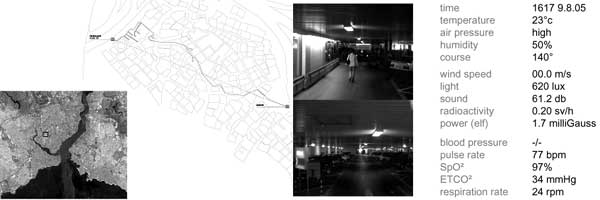 |
| |
O B L I G A T O R Y P A S S P O I N T
MILO LAVÉN, ELIN STRAND, LINUS ELMES STOCKHOLM/SWEDEN
This project explores the interaction between the human body and the city. It maps the city by measuring a multitude of its factors and at the same time registering the body's reaction to these factors.
By forcing the body to perform a straight line through the city, we can measure the resistance of the city. Every departure from the line says something about the obstacles of the city - visible and non-visible, physical and mental - that the body encounters.
This vehicle is an application for integration of a number of different measuring instruments carried within a measuring station on the back.
The gauges consist of two categories; collecting data from the city and collecting data from the body. Factors that are registered from outside the body are; humidity, radiation, wind speed, temperature, magnetic fields, light condition and sound.
The physical factors measured from the body are; pulse rate, blood pressure, respiration rate, carbon dioxide in breath and amount of oxygen in the blood. (Excerpted from the VROOM booklet text of Milo Lavén, Elin Strand & Linus Elmes) |
| | 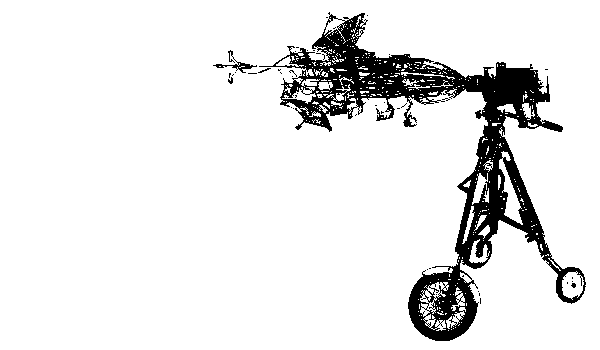 |








